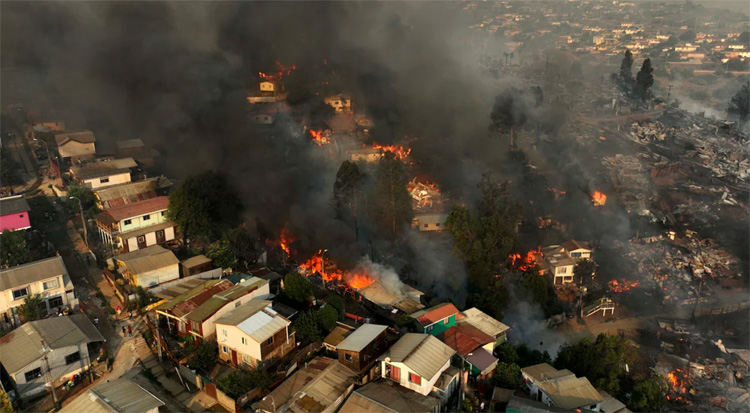We know, often with abject precision, what climate change is doing to our coasts, rainforests, wildfires and hurricanes; our immigration patterns, crop yields and insurance premiums.
But what is it doing to our brains?
This question, for Clayton Page Aldern, is not rhetorical but bleakly literal. Aldern is a Rhodes Scholar who, in defiance of career counselors everywhere, abandoned a promising career in the field of neuroscience to become a journalist. He traces his conversion to a pair of reports showing a correlation between climate change and increased violent conflict. “It wasn’t just that a warmer world would hurt us,” writes Aldern, “it was that a warmer world would make us hurt one another.”
Most of the violence cited in those reports derives from the effect of higher temperatures on natural resources and weather disasters. A report from the Pentagon describes, for instance, how drought and reduced agricultural yields helped prime the Syrian civil war, and how Hurricane Sandy necessitated the mass mobilisation of the US military. But it is also true that heat makes people irritable. How much more anger — how many more shootings, road-rage accidents, sporting-event brawls, declarations of war — is stimulated by a warming of one-and-a-half degrees Celsius? How about two degrees, or three? Warmer temperatures also tend to make us more cruel, depressed and dumb.
The weight of the Weight of Nature falls heavily on the problems, which draw from a survey of experimental findings so terrifying that they elicit the prose equivalent of nervous laughter; many of them, as Aldern writes in reference to the prospect of global-warming-induced mass dementia, are “almost comically apocalyptic.”
Neurodegenerative diseases will affect some 14 million more people annually by 2050. As landscapes reconfigure and cultural practices vanish, the mind becomes less able to retain information, which Aldern translates as: “Climate change causes amnesia.”
In hotter climates, a high school student’s chance of graduating on time decreases by a percentage point for every extra degree Fahrenheit on the day of a final exam. On warmer days immigration judges more frequently rule against asylum applicants. When it’s hotter than 100 degrees, one third of drivers honk more often, and for longer. Heat exposure during early pregnancy is associated with a higher risk of conditions like schizophrenia and anorexia.
Dolphins appear to be getting Alzheimer’s disease. Mountaintop removal makes Appalachians depressed. In Greenland, mercury, a neurotoxin, is leaking from melting permafrost “like some kind of cartoonish sludge zombie.” Florida will soon be swarmed by rabid vampire bats.
Some of the revelations in this “Pandora’s box of horrors” raise practical questions. If students are 10 per cent more likely to fail an exam taken on a 90-degree day, should the test scores of children in southern climates be rounded up accordingly? If higher temperatures lead to outbursts of violence, should a hot day be considered a mitigating factor when determining the guilt of a defendant? Should parents be warned against raising children in tropical zones?
Like any kind of intoxication, indulgence in worst-case scenarios can induce a hangover. Since many of these findings are predicated on extrapolations, Aldern, the former scientist, is careful to include qualifications. “It’s important not to overreach here,” he writes, directly after quoting Crime and Punishment to demonstrate the influence of heat on murderous rage. “Don’t pay attention to the actual values,” he writes, after relaying an economist’s prediction that, between 2010 and 2099, climate change will cause an additional 22,000 murders, 2.2 million cases of larceny and 180,000 cases of rape. In summary: “I know doomsday alarmism is tiresome.
But you should still be concerned.”
It is impossible to submit to this barrage and not be concerned. Any person who dares to stare down the behemoth of climate change cannot escape its mind-altering influence. How does one respond, intellectually or emotionally, to an unravelling that seems both unobservably slow and teeth-chatteringly rapid; to the unthinking and indiscriminate slaughter of billions of creatures; to the ineptitude of our politics and the psychopathic venality of our industries; to the assignation of the most vulnerable among us to the gravest suffering; to the wilful destruction of a civilisation? The scale of the physical transformation alone overwhelms the mind.
Aldern asserts that he has not written a book about climate anxiety — or climate communication or neurophilosophy or politics — but one about “direct interventions of environmental change on the brain.”
Nevertheless, as he puts it elsewhere, “bank shots still count in billiards.” Regardless of whether you live in a wildfire zone or a hurricane alley, or swim in warm ponds, his central insights hold, and deserve emphasis. Aldern is the rare writer who dares to ask how climate change has already changed us.
“It is the job of your brain to model the world as it is,” writes Aldern. “And the world is mutating.” We are mutating with it. We are becoming more suspicious, paranoid, anxious, depressive, distracted, nihilistic, angry. Not all of us, and not all the time. Some respond, as Aldern instructs his readers to do, with greater empathy, resilience, collective action and pipeline sabotage.
But that is just another kind of mutation: an antibody response. This great transformation is already deforming our inner lives in ways we are only beginning to comprehend. Climate change isn’t only here, writes Aldern. It is inside us. And it is spreading.

